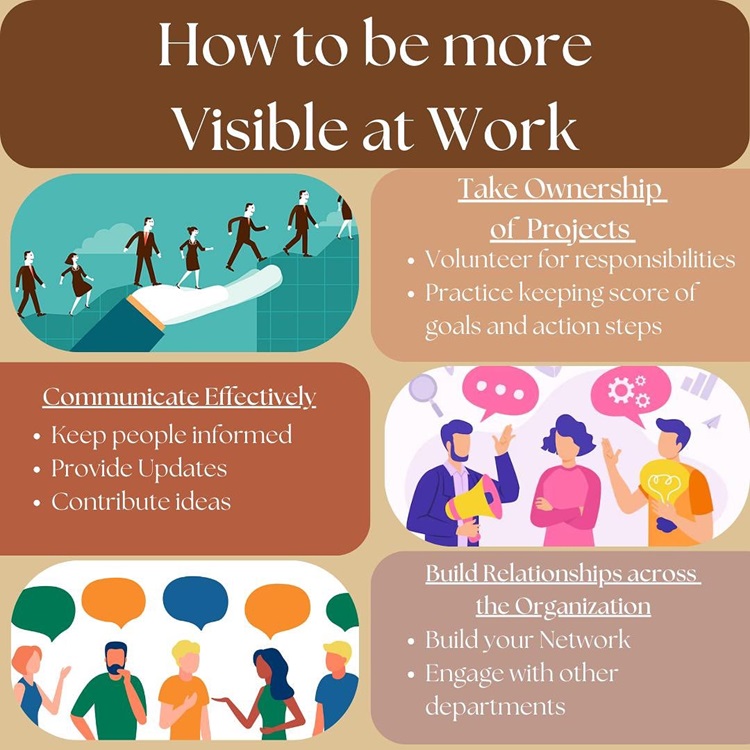A crucial jigsaw piece of professional development is being visible. Yet, this is just more than being seen in the office or logging into meetings. It goes beyond the physical and into making a noticeable impact that shows value to the organization. Whether it is being promoted, getting a raise, or forging stronger professional relationships, visibility at work plays an important role in securing one’s edge in the workplace.
The power of visibility can never be underestimated. – Margaret Cho, American comedian, actress, musician, & activist
|
Author: Aaron Ngui |
Highlights
- Workplace visibility is essential because “if you are not visible, you are invisible.” Leaders must be able to notice and recognize an individual’s efforts and contributions to consider them for mission-critical projects, promotions, and career advancement. It also boosts morale and a sense of belonging.
- Gaining recognition requires a proactive approach, not chance. Key strategies include taking ownership of projects (especially high-profile ones), communicating effectively by providing regular updates and actively participating in meetings, and building relationships across the organization through networking and finding a mentor or advocate.
- Remote and hybrid work necessitates different tactics due to the lack of physical presence. Remote workers should stay connected with scheduled check-ins, be proactive in documenting and sharing successes (e.g., weekly accomplishment emails), and use video during virtual meetings to maintain a stronger presence and rapport.
- Common obstacles like shyness and impostor syndrome can be managed by starting small, rehearsing contributions, and focusing on a “victory log” of accomplishments. Leaders play a crucial role by publicly celebrating team successes, providing platforms for employees to share their work, and offering opportunities for high-visibility projects.
Why Visibility at Work Matters
Being visible at work is often an overlooked capability. Nonetheless, it is essential for anyone desiring career advancement. If an individual’s efforts are not recognized, or noticed, leaders may find it difficult to give them mission-critical projects that can lead to recognition and promotions.
ITD World’s partner Stephen Krempl likes to say, “If you are not visible, you are invisible.” Visibility helps people stand out and makes it easier for decision-makers to not only see the contributions – but also to consider them for career advancement. For example, those who actively share progress or volunteer to leadership roles in team projects demonstrate initiative and commitment. These are qualities that are valuable in organizations driving for high performance.
In addition, people who are intentional in gaining higher visibility foster in themselves a stronger sense of belonging and purpose. Morale is boosted when efforts are acknowledged and recognized. This creates a positive feedback loop of recognition that fuels further accomplishments.
While being visible is important, overdoing it may sometimes come off as self-promotional. The key is to focus on genuinely adding value to the team rather than seeking visibility for its own sake. Authenticity and a collaborative mindset ensure that efforts are well-received.
It is good to keep in mind that workplace visibility is not about who shouts the loudest. Ultimately, it is about ensuring the work is not being kept in the shadows and so prevents careers from flourishing.

How to Be More Visible at Work
Getting recognized does not happen by chance or coincidence; it requires a proactive approach, in which one takes deliberate actions to highlight their contributions.

-
Take ownership of projects
One of the most impactful ways to become visible is by taking ownership of projects. Volunteering for new responsibilities, especially those that are challenging or high-profile, shows initiative and gives people the opportunity to demonstrate their problem-solving capabilities. Stepping up showcases the willingness to align their effort with key business objectives.
On a related note, cultivate the practice of keeping score of goals and action steps, and the habit of regularly giving progress updates in formal meetings or informal conversations. This helps keep the person’s work at the top of mind in the decision-maker’s eye.
-
Communicate effectively
Keeping managers informed about ongoing tasks and achievements can make a difference. Provide regular updates on the status of projects, especially after reaching a major milestone or overcoming a significant challenge. A person can make their presence known by actively participating in meetings; contributing ideas, asking questions, and sharing feedback. This demonstrates engagement and adds value to the discussion.
Also, make the most of digital communication tools such as emails, instant messaging, and video calls to stay in touch with the team. Don’t wait for others to notice you; make your contributions known by speaking up and sharing progress.
-
Build relationships across the organization
Network building is another crucial step in becoming more visible at work. Building relationships with colleagues from different departments helps people gain recognition beyond their immediate team. Engage in conversations, participate in cross-departmental projects, and seek out opportunities for collaboration. Attending social events, company gatherings, or informal meetups can further strengthen these relationships.
In addition, finding a mentor or advocate within the organization can also significantly raise a person’s profile. Mentors provide valuable guidance, share their experiences, and help you navigate the organizational landscape, while advocates can vouch for your work when you are not in the room.
Conversely, volunteering to mentor others can also help boost visibility as people come to you for wisdom, expertise, and insights.
Strategies for Remote Workers
Remote or hybrid work presents unique challenges for visibility since being present physically is not an option. As the ability to casually pop by the manager’s office, or a quick chat in the hallway is not there, those working remotely should employ different approaches.
-
Stay connected
Maintain strong connections with colleagues and supervisors by scheduling regular check-ins with managers to discuss progress, challenges, and future goals. Consistent communication builds trust and ensures that work stays on the radar of decision-makers. Take the effort to participate in virtual social events, such as online coffee chats or team-building activities, which helps to strengthen professional networks.
-
Make your work known
Being proactive in communicating achievements is crucial when working from home. Documenting successes and sharing them with the team or manager keeps work visible. This can be as simple as an email summarizing the weekly accomplishments.
Additionally, turning on the video feed, instead of switching the camera off, during virtual meetings helps maintain a stronger presence. When the camera is on, others can see expressions which builds rapport in ways that text or audio alone cannot.
Also, tap on the power of being responsive – quick replies to emails and messages demonstrate engagement and availability.
Read more: Executive Presence – Key Strategies for Professional Success

Overcoming Common Barriers to Visibility
It’s normal to face obstacles when trying to be more visible at work. Common challenges include shyness, impostor syndrome, or even feeling overshadowed by more outspoken colleagues. Consider these approaches to overcome these barriers:
-
Overcoming shyness
The thought of speaking up in meetings can seem daunting for those with an introverted streak. Yet, those who are shy may start small by contributing their thoughts in less formal settings that are not so intimidating. For example, there is less pressure in team meetings. Gain the confidence to speak out by rehearsing what you want to say ahead of time. Getting familiar with the information goes a long way in being comfortable when speaking to a crowd.
Also, seeking feedback from a trusted colleague helps people improve their presentation and feel more confident about sharing ideas. Over time, taking these steps will make speaking up a natural habit rather than a stressful ordeal. It may seem uncomfortable at first, but being willing to leave the comfort zone is one of the first steps to getting seen.
-
Handling impostor syndrome
Impostor syndrome is an obstacle for many to feel deserving of recognition. People who often find themselves doubting their abilities are encouraged to reframe and focus on their achievements and the value they bring to the team. Do so by keeping a list of accomplishments as a reminder of progress.
In the book 5 Levels of Mastery, the authors label this collection of achievements a victory log. Having this compilation of wins, and sharing it during the regular check-in times ensures people know about the positive developments.
Meanwhile, viewing setbacks as opportunities for growth, rather than failures, can shift the mindset toward continuous improvement. The more you talk about your work, the easier it becomes to acknowledge your contributions openly and confidently.
I don’t hurt or want for visibility, but people seem to forget pretty easily. – Gary Coleman, American actor
The Role of Leaders in Promoting Visibility
Managers play a key role in fostering a culture where employees feel valued and visible. As a leader, take steps to regularly acknowledge the successes of the team and its members. Publicly celebrating wins during meetings or in company newsletters can significantly enhance visibility.
In addition, constantly encourage team members to share updates on their projects and present ideas during discussions, allowing them to demonstrate their expertise. Providing employees with opportunities to take on high-visibility projects or work with senior leaders ensures they have the platform needed to grow and be recognized.
Measuring the Impact of Increased Visibility
It is important to assess the impact of strategies and approaches to increase visibility in the workplace. Indicators of success may include increased recognition from colleagues or leadership, more opportunities for growth such as promotions or new responsibilities, and stronger relationships across different teams or departments. If these results are evident, it is likely that the efforts to enhance visibility are paying off.
However, if visibility continues to be a challenge, it may be necessary to reassess the strategies and seek feedback from mentors, managers, or colleagues to refine the approach and to better showcase impact, contributions, and value.
“The gem cannot be polished without friction, nor man perfected without trials.” — Chinese proverb
Other resources you might be interested in:
- 10 L&D Trends to Help Your Workforce Thrive
- Aligning Individual Goals With Organizational Goals
- Diversity in the Workplace: How It Fuels Success

